Here is a very naive approach: simply interpolating between top and bottom vertices (that are sorted left to right) based on how many division/'rows' you need.
I've done a quick test using Processing:
PShape svg,shape;
int divisions = 3;
ArrayList<PVector> top = new ArrayList<PVector>();
ArrayList<PVector> bottom = new ArrayList<PVector>();
int numVerts;
int ptSize = 5;
void setup(){
svg = loadShape("shape.svg");
size((int)svg.width,(int)svg.height);
shape = svg.getChild(0);
//find top and bottom vertices
numVerts = shape.getVertexCount();
float minY = height,maxY = 0;
for(int i = 0 ; i < numVerts; i++){
PVector v = shape.getVertex(i);
if(v.x < minY) minY = v.y;
if(v.y > maxY) maxY = v.y;
}
float yThresh = (maxY-minY) * .25;//1/4 of height as top/bottom thresh
//store vertices belonging to top and bottom based on min and max y values and threshold
for(int i = 0 ; i < numVerts; i++){
PVector v = shape.getVertex(i);
if(v.y <= minY+yThresh) top.add(v);
if(v.y >= maxY-yThresh) bottom.add(v);
}
//manual left to right sorting, this needs to be implemented properly
PVector last = bottom.get(bottom.size()-1);
PVector first = bottom.get(0);
bottom.set(0,last);
bottom.set(bottom.size()-1,first);
//assumptions is top is a list of the top vertices of the contour sorted left to right
//and simillary bottom is a list of bottom vertices, sorted left to right
}
void draw(){
background(255);
shape(shape,0,0);
//visualize top/bottom vertices
stroke(0,192,0);
for(PVector v : top) ellipse(v.x,v.y,ptSize,ptSize);
stroke(192,0,0);
for(PVector v : bottom) ellipse(v.x,v.y,ptSize,ptSize);
stroke(0,0,255);
//compute interpolation step value
float lerpStep = 1.0/(divisions+1);
//for each division
for(int i = 0 ; i < divisions; i++){
//loop through contour vertices top to bottom
for(int j = 0 ; j < top.size(); j++){
//get top and bottom vertices
PVector vTop = top.get(j);
PVector vBottom = bottom.get(j);
//interpolate between them
PVector vLerp = PVector.lerp(vTop,vBottom, lerpStep * (i+1));
//draw on screen
ellipse(vLerp.x,vLerp.y,ptSize,ptSize);
}
}
}
void keyPressed(){
if(keyCode == UP) divisions++;
if(keyCode == DOWN) divisions--;
}
And here is shape.svg:
<?xml version="1.0" encoding="utf-8"?>
<!DOCTYPE svg PUBLIC "-//W3C//DTD SVG 1.1//EN" "http://www.w3.org/Graphics/SVG/1.1/DTD/svg11.dtd">
<svg version="1.1" id="Layer_2" xmlns="http://www.w3.org/2000/svg" xmlns:xlink="http://www.w3.org/1999/xlink" x="0px" y="0px"
width="960px" height="560px" viewBox="0 0 960 560" enable-background="new 0 0 960 560" xml:space="preserve">
<polygon fill="#D8D8D8" points="279,100 479,60 681,100 641,501 480,482 322,501 "/>
</svg>
Here is a preview, with top vertices marked green, bottom red and interpolated vertices as blue:

As @Joseph O'Rourke mentions, the problem is more challenging if the bottom and bottom paths aren't similar (same number of vertices and left to right order I guess).
In this case it should be possible to implement a blending algorithm (like this one for example). If you're already playing with various shape in SVG format, you should be able to test if blending solves your problem by trying it in Inkscape or Illustrator beforehand.

